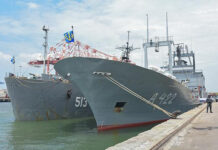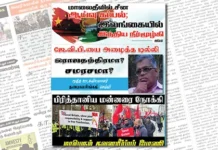It was in the dead of winter when Moscow airdropped several hundred paratroopers into the neighbouring country’s main airfield with orders to capture the capital, kill the president and install a client regime. As tanks also crossed the border, the Kremlin expected the country would quickly fall.
That was Moscow’s plan — for the Soviet Union’s invasion of Afghanistan in 1979. Four decades later, Russian president Vladimir Putin used the same overconfident blueprint for his full-scale invasion of Ukraine, where he similarly imagined a swift capture of Kyiv followed by national capitulation.
“There is a depressingly direct parallel between how a group of ageing men in the Kremlin made a bad decision to invade Afghanistan and how another group of ageing men in the Kremlin made a decision to invade Ukraine,” said veteran Russia expert and historian Mark Galeotti. “In both cases, the military thought the invasion a bad idea, but were overruled.” Moscow’s invasion of Afghanistan left 15,000 Soviet troops dead and led to a 10-year quagmire that only ended after its withdrawal.
In Ukraine, where an estimated 100,000 Russian troops have already been killed or wounded in just 10 months, the Kremlin arguably continues to misread the national mood even more dramatically. Russian forces failed to take the capital Kyiv and Ukrainian troops have since pushed them out from over half the territory they initially seized. Yet Moscow remains seemingly undeterred: Ukraine has repeatedly warned that Russia is planning another land attack on the capital, despite its depleted ability to launch a major ground offensive.
 What other lessons can be drawn from the Ukrainian conflict and how it could unfold in 2023? One key insight, military officials and analysts said, is that “big war is back” and with that the need for countries to have the industrial capacity and massive weapons stocks to sustain high-intensity fighting. Residents run for cover after heavy shelling on the town of Irpin, near Kyiv, in March. Ukraine has repeatedly warned that Russia is planning another land attack on the capital, the UK’s armed forces minister, called the “strategic depth” of its western allies, which have sent more than $40bn of military aid to Ukraine.
What other lessons can be drawn from the Ukrainian conflict and how it could unfold in 2023? One key insight, military officials and analysts said, is that “big war is back” and with that the need for countries to have the industrial capacity and massive weapons stocks to sustain high-intensity fighting. Residents run for cover after heavy shelling on the town of Irpin, near Kyiv, in March. Ukraine has repeatedly warned that Russia is planning another land attack on the capital, the UK’s armed forces minister, called the “strategic depth” of its western allies, which have sent more than $40bn of military aid to Ukraine.
The US will also send its Patriot air defence system as part of a new $1.85bn weapons package. So far, though, the west — wary of escalating a conflict that could lead to direct confrontation between Nato countries and Russia — has resisted providing the modern tanks, long-range missiles and jets also requested by Kyiv. “A key question for 2023 is how much military support the west will continue to provide Ukraine — and what kind,” said Domitilla Sagramoso, a Russia security expert at King’s College in London. A third lesson for Moscow is the importance of quality over quantity.
Good logistics, plentiful troop levels and adequate military hardware — whether drones or tanks — “are worth nothing if the force’s intelligence, leadership . . . are inadequate”, said Ben Barry, a former British army brigadier now at the International Institute for Strategic Studies think-tank. Instead, Russian forces have continued to show “low morale and weak standards of combined arms tactics and battlefield leadership”, Barry said. Moscow’s 10-year quagmire in Afghanistan left 15,000 Soviet troops dead © Sipa/Shutterstock In an effort to rectify that, Putin in October appointed General Sergey Surovikin to command Russia’s forces in Ukraine.
Surovikin, a veteran of the war in Syria, is “probably the most competent commander Russia has put in place”, said Dara Massicot, a Russia military expert at the Rand Corporation think-tank. Surovikin has reinforced Russia’s frontlines with recruits drawn from the recent draft of approximately 300,000 soldiers. He also engineered a successful withdrawal from around the strategic southern city of Kherson, where Russian forces were in danger of being captured.
These stronger defensive positions reduce the chances of a successful Ukrainian winter counter-offensive that cuts the land bridge which runs along the coast of the Sea of Azov and links Russia to Crimea, although a breakthrough is still regarded as possible by western military analysts. “Ukrainian forces . . . certainly face their own problems. Their casualties have been high, many are not adequately trained, some units are clearly suffering from extreme fatigue and they need more weapons and ammunition,” one western defence adviser said.
“But their morale and determination are still incomparably higher than their opponents’, and they have been much more effective than the Russians in mobilising.” Conscripted Russians say goodbye to relatives at a recruitment office in Moscow in September.
A fourth lesson is the importance of civil society in sustaining the war effort. Ukrainian software programmers have designed apps to help their troops target Russian positions, chefs cook food for Ukrainian soldiers on the frontlines and volunteers continue to raise funds to buy military supplies such as first aid kits and night vision goggles. “Much of Ukrainians’ success on the battlefield depends on a heterogenous and self-confident civil society, capable of supporting soldiers,” said Timothy Snyder, a Yale University historian.
An October Gallup poll showed 70 per cent of Ukrainians wanted to continue fighting until they achieved victory, and more than 90 per cent believed victory meant recapturing all territory seized by Russia, including Crimea, which Putin annexed in 2014. By contrast, popular Russian support for the war halved between June and November to 27 per cent, according to an unverified internal Kremlin poll reported by exiled news outlet Meduza.
Recommended Constanze Stelzenmüller The west’s axis of prudence risks a Kremlin victory by default in Ukraine The fifth and perhaps biggest lesson from the war is that it is being fought on multiple fronts and not just with tanks, rockets and guns. Putin has launched a relentless wave of missile and drone attacks on Ukraine’s energy infrastructure to try and break the national will and unleash a wave of refugees into Europe. He has threatened further cuts to western gas supplies as winter sets in, and while Ukraine is shipping grain under a deal brokered by Turkey and the UN, Russia’s navy still controls the Black Sea, menacing much of Ukraine’s food export routes.
“Putin’s message seems to be the shooting will go on, but I can continue this as long as I want,” said Galeotti. “It’s a political strategy that’s designed to distance Ukraine from the west. How this war proceeds is not just about military equipment.” Even if both sides, exhausted by the fighting, agree a ceasefire in the coming year, Putin’s aggression against Ukraine could still continue through these other means. “The character of modern war may be changing but so has the nature of peace,” Galeotti added. “That is something the west needs to think about.”
FT.





